VOLVO S70 1998 Owners Manual
Manufacturer: VOLVO, Model Year: 1998, Model line: S70, Model: VOLVO S70 1998Pages: 52, PDF Size: 0.89 MB
Page 1 of 52
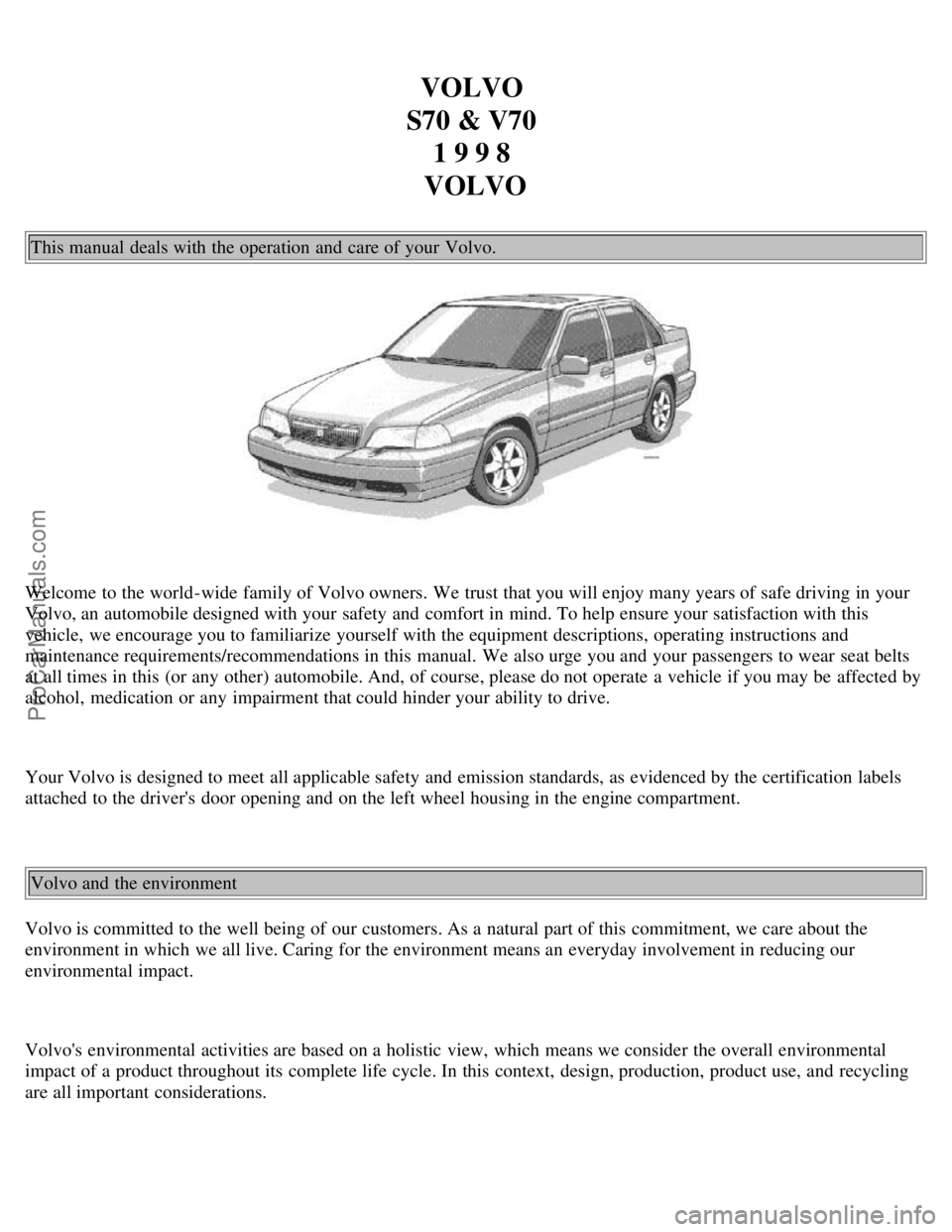
VOLVO
S70 & V70 1 9 9 8
VOLVO
This manual deals with the operation and care of your Volvo.
Welcome to the world-wide family of Volvo owners. We trust that you will enjoy many years of safe driving in your
Volvo, an automobile designed with your safety and comfort in mind. To help ensure your satisfaction with this
vehicle, we encourage you to familiarize yourself with the equipment descriptions, operating instructions and
maintenance requirements/recommendations in this manual. We also urge you and your passengers to wear seat belts
at all times in this (or any other) automobile. And, of course, please do not operate a vehicle if you may be affected by
alcohol, medication or any impairment that could hinder your ability to drive.
Your Volvo is designed to meet all applicable safety and emission standards, as evidenced by the certification labels
attached to the driver's door opening and on the left wheel housing in the engine compartment.
Volvo and the environment
Volvo is committed to the well being of our customers. As a natural part of this commitment, we care about the
environment in which we all live. Caring for the environment means an everyday involvement in reducing our
environmental impact.
Volvo's environmental activities are based on a holistic view, which means we consider the overall environmental
impact of a product throughout its complete life cycle. In this context, design, production, product use, and recycling
are all important considerations.
ProCarManuals.com
Page 2 of 52
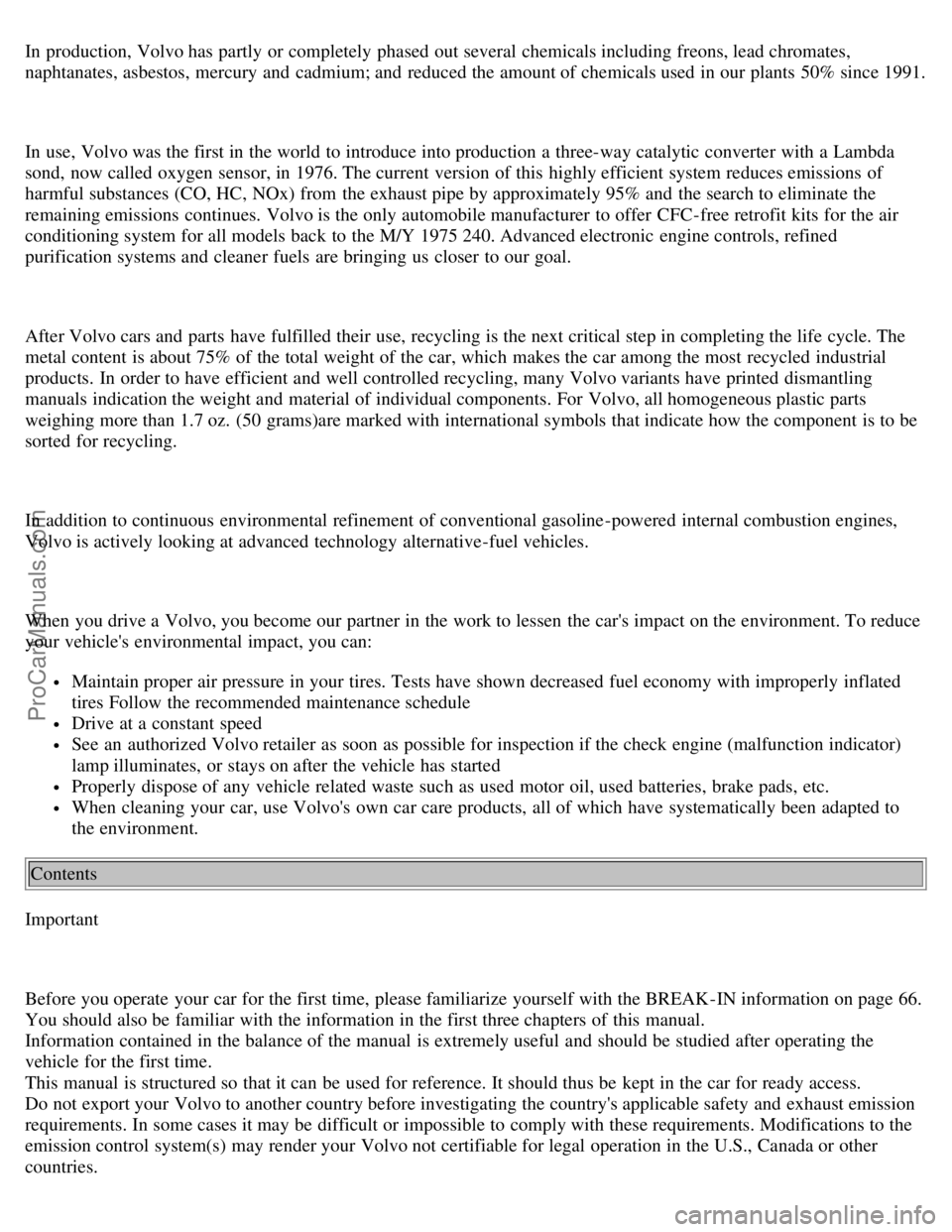
In production, Volvo has partly or completely phased out several chemicals including freons, lead chromates,
naphtanates, asbestos, mercury and cadmium; and reduced the amount of chemicals used in our plants 50% since 1991.
In use, Volvo was the first in the world to introduce into production a three-way catalytic converter with a Lambda
sond, now called oxygen sensor, in 1976. The current version of this highly efficient system reduces emissions of
harmful substances (CO, HC, NOx) from the exhaust pipe by approximately 95% and the search to eliminate the
remaining emissions continues. Volvo is the only automobile manufacturer to offer CFC-free retrofit kits for the air
conditioning system for all models back to the M/Y 1975 240. Advanced electronic engine controls, refined
purification systems and cleaner fuels are bringing us closer to our goal.
After Volvo cars and parts have fulfilled their use, recycling is the next critical step in completing the life cycle. The
metal content is about 75% of the total weight of the car, which makes the car among the most recycled industrial
products. In order to have efficient and well controlled recycling, many Volvo variants have printed dismantling
manuals indication the weight and material of individual components. For Volvo, all homogeneous plastic parts
weighing more than 1.7 oz. (50 grams)are marked with international symbols that indicate how the component is to be
sorted for recycling.
In addition to continuous environmental refinement of conventional gasoline-powered internal combustion engines,
Volvo is actively looking at advanced technology alternative-fuel vehicles.
When you drive a Volvo, you become our partner in the work to lessen the car's impact on the environment. To reduce
your vehicle's environmental impact, you can:
Maintain proper air pressure in your tires. Tests have shown decreased fuel economy with improperly inflated
tires Follow the recommended maintenance schedule
Drive at a constant speed
See an authorized Volvo retailer as soon as possible for inspection if the check engine (malfunction indicator)
lamp illuminates, or stays on after the vehicle has started
Properly dispose of any vehicle related waste such as used motor oil, used batteries, brake pads, etc.
When cleaning your car, use Volvo's own car care products, all of which have systematically been adapted to
the environment.
Contents
Important
Before you operate your car for the first time, please familiarize yourself with the BREAK-IN information on page 66.
You should also be familiar with the information in the first three chapters of this manual.
Information contained in the balance of the manual is extremely useful and should be studied after operating the
vehicle for the first time.
This manual is structured so that it can be used for reference. It should thus be kept in the car for ready access.
Do not export your Volvo to another country before investigating the country's applicable safety and exhaust emission
requirements. In some cases it may be difficult or impossible to comply with these requirements. Modifications to the
emission control system(s) may render your Volvo not certifiable for legal operation in the U.S., Canada or other
countries.
ProCarManuals.com
Page 3 of 52
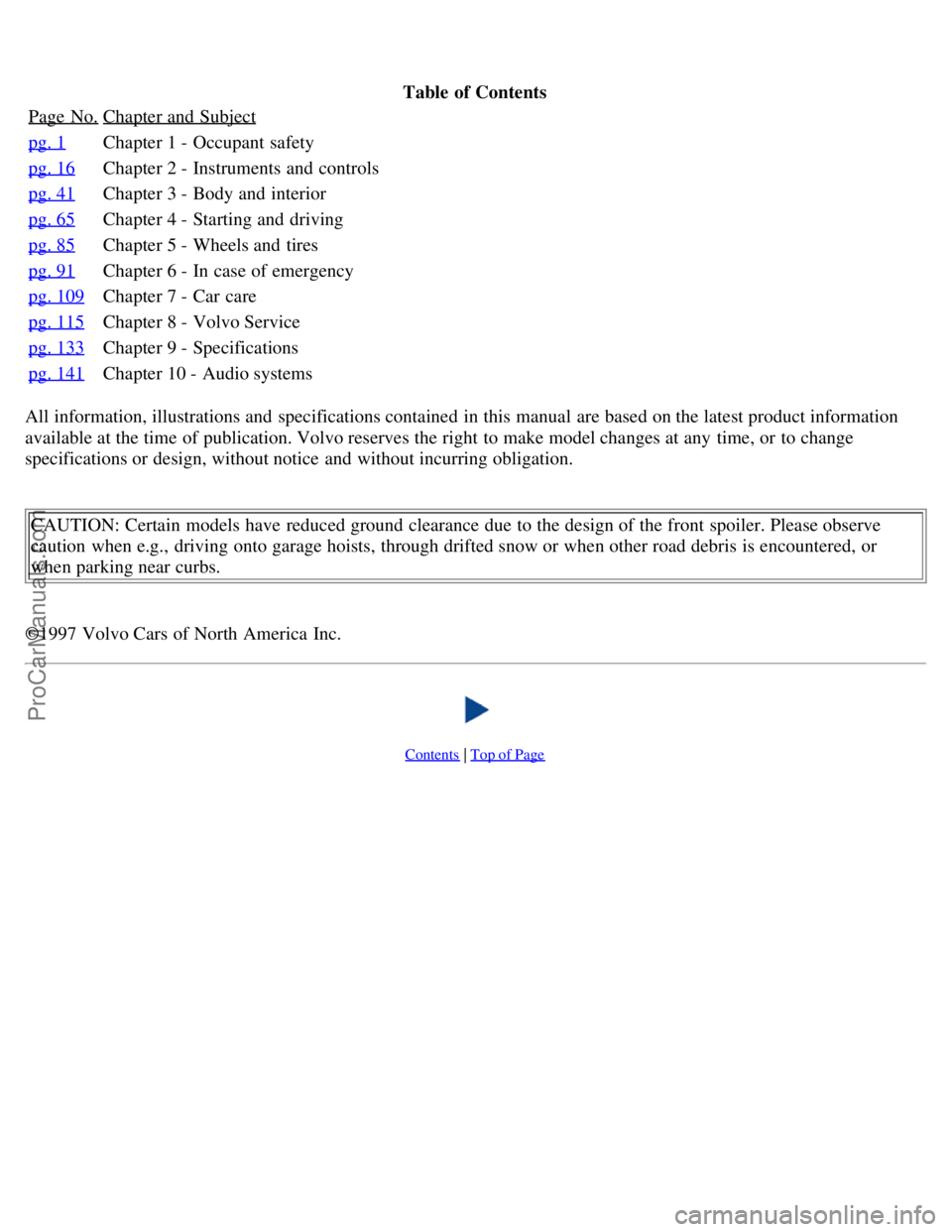
Table of Contents
Page No.
Chapter and Subject
pg. 1Chapter 1 - Occupant safety
pg. 16
Chapter 2 - Instruments and controls
pg. 41
Chapter 3 - Body and interior
pg. 65
Chapter 4 - Starting and driving
pg. 85
Chapter 5 - Wheels and tires
pg. 91
Chapter 6 - In case of emergency
pg. 109
Chapter 7 - Car care
pg. 115
Chapter 8 - Volvo Service
pg. 133
Chapter 9 - Specifications
pg. 141
Chapter 10 - Audio systems
All information, illustrations and specifications contained in this manual are based on the latest product information
available at the time of publication. Volvo reserves the right to make model changes at any time, or to change
specifications or design, without notice and without incurring obligation.
CAUTION: Certain models have reduced ground clearance due to the design of the front spoiler. Please observe
caution when e.g., driving onto garage hoists, through drifted snow or when other road debris is encountered, or
when parking near curbs.
©1997 Volvo Cars of North America Inc.
Contents | Top of Page
ProCarManuals.com
Page 4 of 52
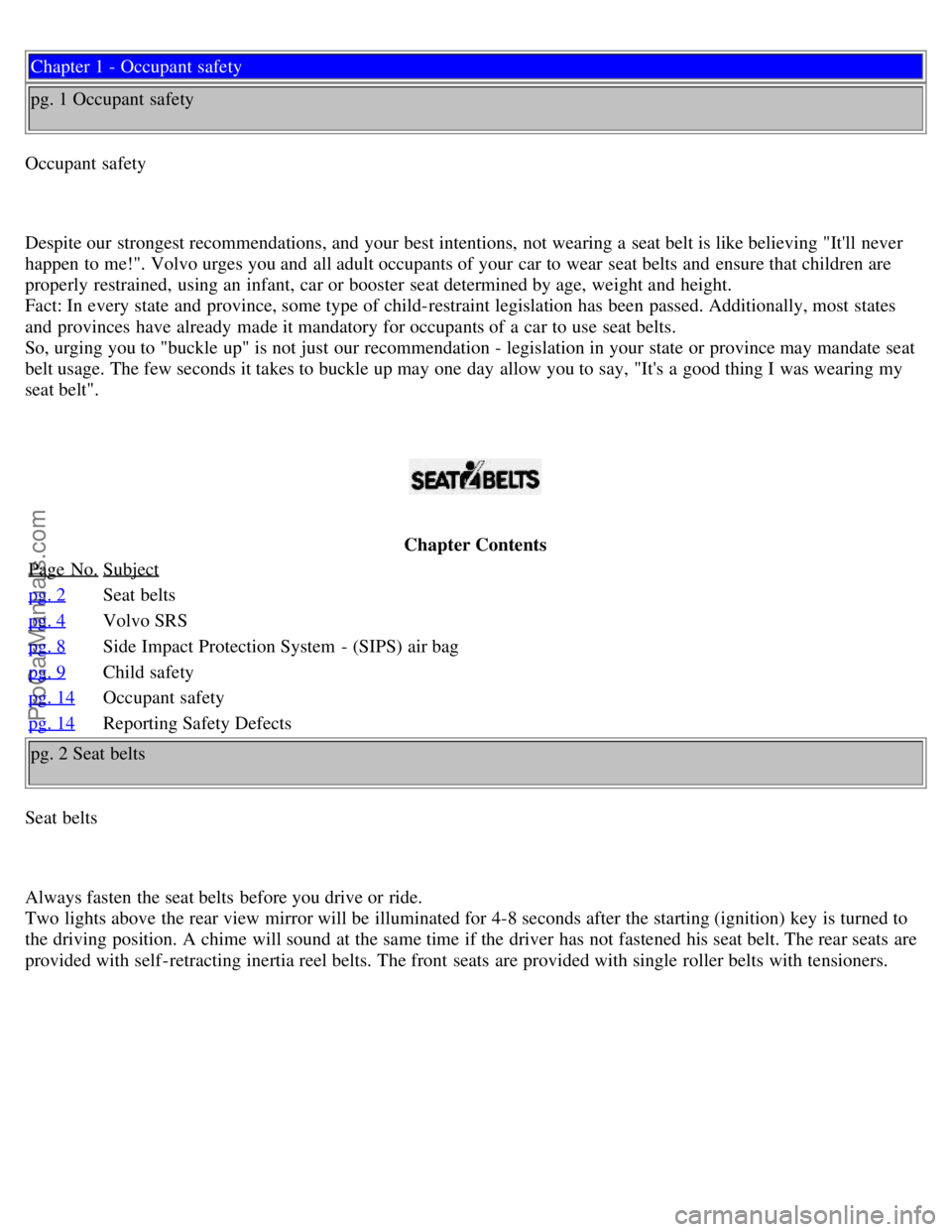
Chapter 1 - Occupant safety
pg. 1 Occupant safety
Occupant safety
Despite our strongest recommendations, and your best intentions, not wearing a seat belt is like believing "It'll never
happen to me!". Volvo urges you and all adult occupants of your car to wear seat belts and ensure that children are
properly restrained, using an infant, car or booster seat determined by age, weight and height.
Fact: In every state and province, some type of child-restraint legislation has been passed. Additionally, most states
and provinces have already made it mandatory for occupants of a car to use seat belts.
So, urging you to "buckle up" is not just our recommendation - legislation in your state or province may mandate seat
belt usage. The few seconds it takes to buckle up may one day allow you to say, "It's a good thing I was wearing my
seat belt".
Chapter Contents
Page No.
Subject
pg. 2Seat belts
pg. 4
Volvo SRS
pg. 8
Side Impact Protection System - (SIPS) air bag
pg. 9
Child safety
pg. 14
Occupant safety
pg. 14
Reporting Safety Defects
pg. 2 Seat belts
Seat belts
Always fasten the seat belts before you drive or ride.
Two lights above the rear view mirror will be illuminated for 4-8 seconds after the starting (ignition) key is turned to
the driving position. A chime will sound at the same time if the driver has not fastened his seat belt. The rear seats are
provided with self -retracting inertia reel belts. The front seats are provided with single roller belts with tensioners.
ProCarManuals.com
Page 5 of 52

To buckle:
Pull the belt out far enough to insert the latch plate into the receptacle (buckle for rear seats) until a distinct snapping
sound is heard. The seat belt retractor is normally "unlocked" and you can move freely, provided that the shoulder belt
is not pulled out too far. The retractor will lock up as follows:
if the belt is pulled out rapidly
during braking and acceleration
if the vehicle is leaning excessively
when driving in turns
For the seat belt to provide maximum protection in the event of an accident, it must be worn correctly. When wearing
the seat belt remember:
The belt should not be twisted or turned.
The lap belt must be positioned low on the hips (not pressing against the abdomen).
The shoulder section of the front seat belts adjusts automatically to the driver's height.
Make sure that the shoulder belt is rolled up into its retractor and that the shoulder and lap belts are taut.
Before exiting the car, check that the seat belt retracts fully after being unbuckled.
If necessary, guide the belt back into the retractor slot.
NOTE: Legislation in your state or province may mandate seat belt usage.
WARNING! Any device used to induce slack into the shoulder belt portion of the three-point belt system will have a
detrimental effect on the amount of protection available to you in the event of a collision. The seat back should not be
tilted too far back. The shoulder belt must be taut in order to function properly.
Spool-out
To make child seat installation easier, each seat belt buckle (except for the driver's belt) is equipped with a locking
mechanism to help keep the lap section of the seat belt taut. Please refer to page 12 for more information on this
function. WARNING! Do not use child safety seats or child booster cushions/backrests in the front passenger's seat. We also
recommend that children who have outgrown these devices sit in the rear with the seat belt properly fastened.
ProCarManuals.com
Page 6 of 52
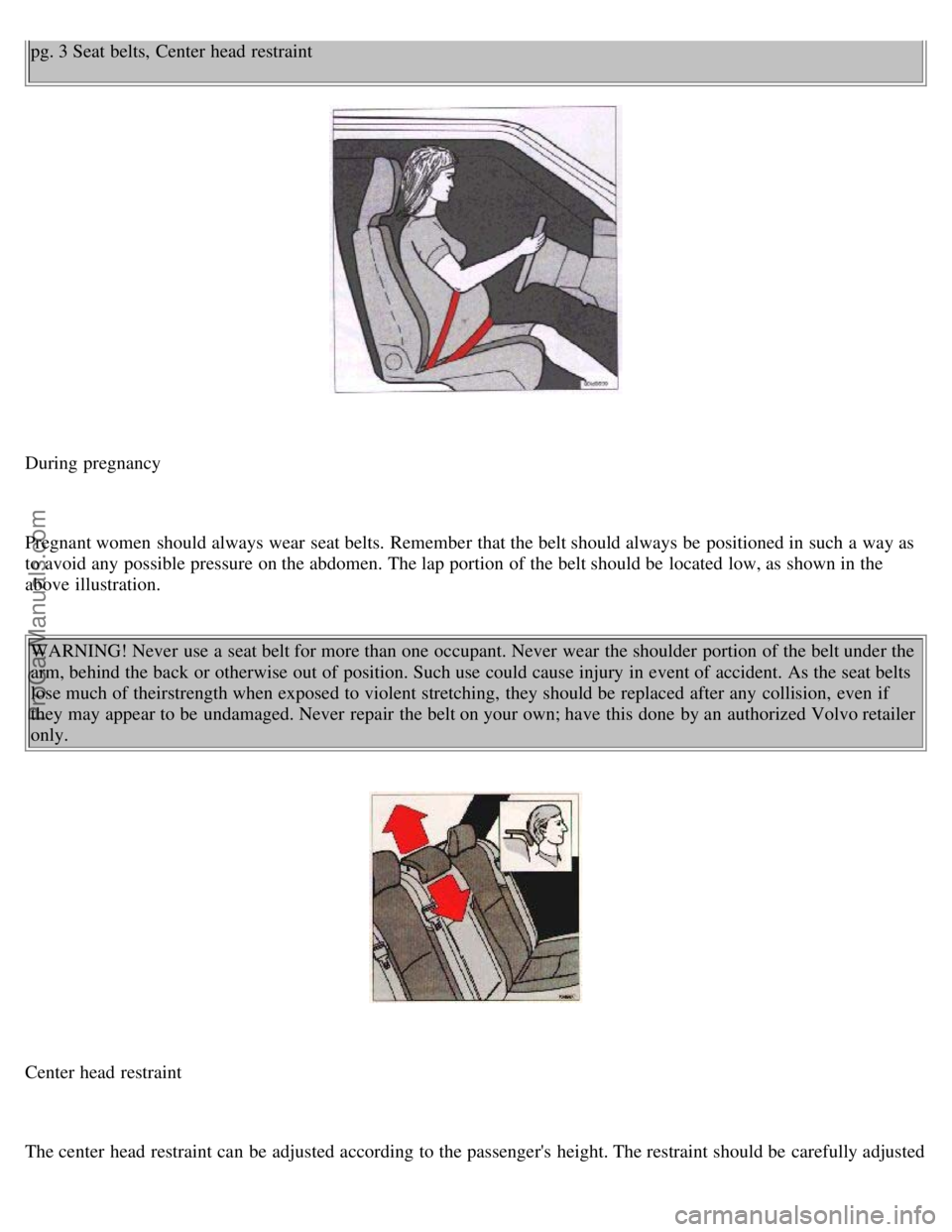
pg. 3 Seat belts, Center head restraint
During pregnancy
Pregnant women should always wear seat belts. Remember that the belt should always be positioned in such a way as
to avoid any possible pressure on the abdomen. The lap portion of the belt should be located low, as shown in the
above illustration.WARNING! Never use a seat belt for more than one occupant. Never wear the shoulder portion of the belt under the
arm, behind the back or otherwise out of position. Such use could cause injury in event of accident. As the seat belts
lose much of theirstrength when exposed to violent stretching, they should be replaced after any collision, even if
they may appear to be undamaged. Never repair the belt on your own; have this done by an authorized Volvo retailer
only.
Center head restraint
The center head restraint can be adjusted according to the passenger's height. The restraint should be carefully adjusted
ProCarManuals.com
Page 7 of 52
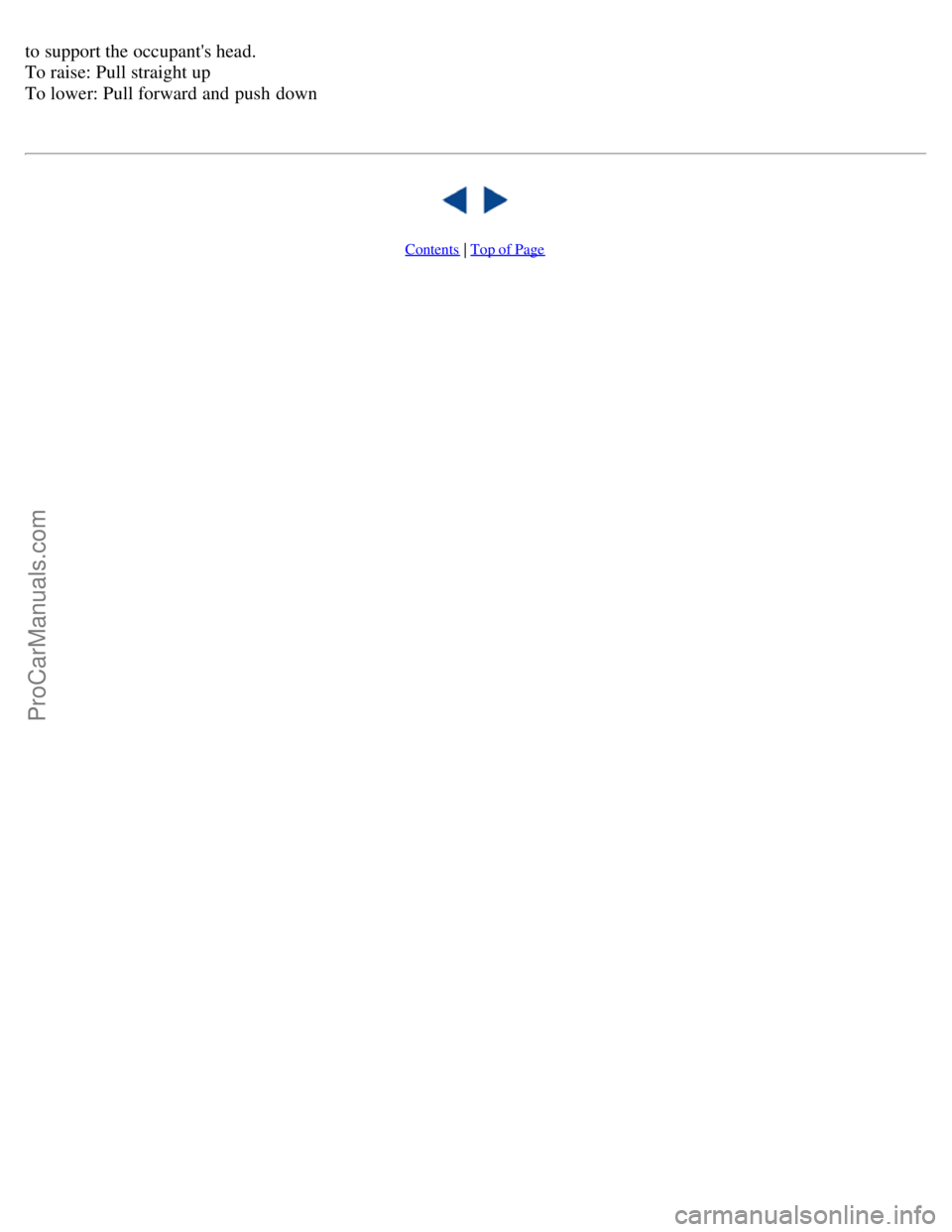
to support the occupant's head.
To raise: Pull straight up
To lower: Pull forward and push down
Contents | Top of Page
ProCarManuals.com
Page 8 of 52
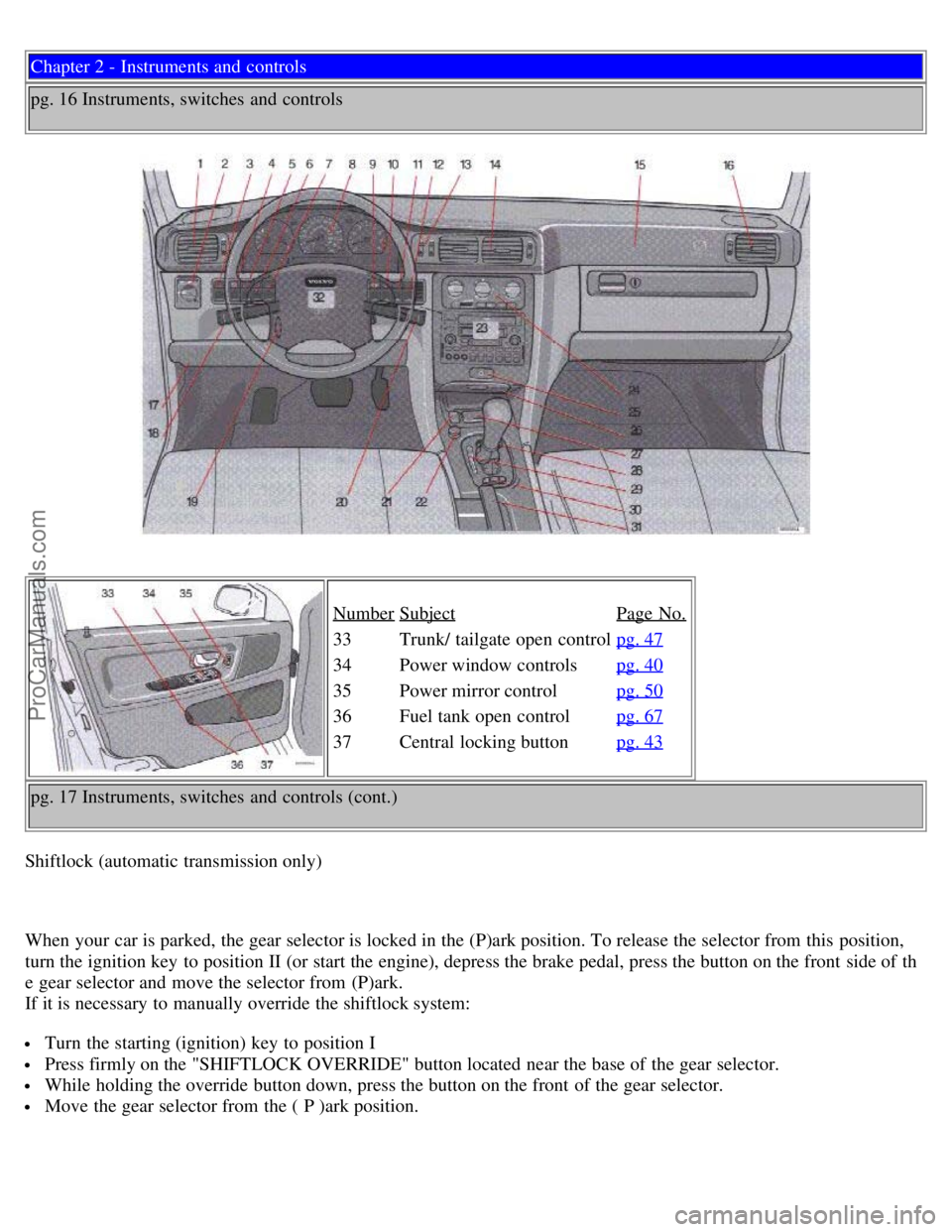
Chapter 2 - Instruments and controls
pg. 16 Instruments, switches and controls
NumberSubjectPage No.
33Trunk/ tailgate open control pg. 47
34Power window controls pg. 40
35Power mirror control pg. 50
36Fuel tank open control pg. 67
37Central locking button pg. 43
pg. 17 Instruments, switches and controls (cont.)
Shiftlock (automatic transmission only)
When your car is parked, the gear selector is locked in the (P)ark position. To release the selector from this position,
turn the ignition key to position II (or start the engine), depress the brake pedal, press the button on the front side of th
e gear selector and move the selector from (P)ark.
If it is necessary to manually override the shiftlock system:
Turn the starting (ignition) key to position I
Press firmly on the "SHIFTLOCK OVERRIDE" button located near the base of the gear selector.
While holding the override button down, press the button on the front of the gear selector.
Move the gear selector from the ( P )ark position.
ProCarManuals.com
Page 9 of 52
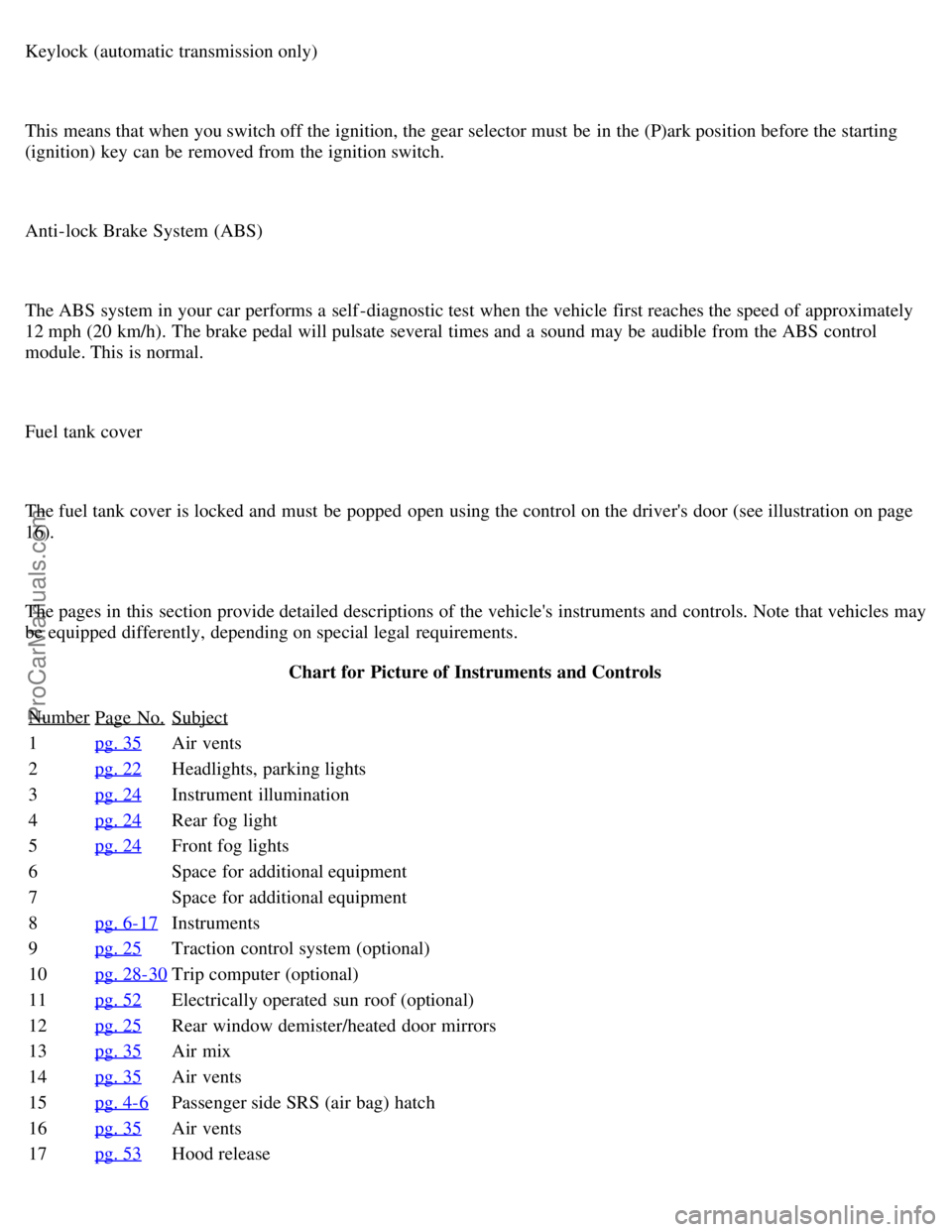
Keylock (automatic transmission only)
This means that when you switch off the ignition, the gear selector must be in the (P)ark position before the starting
(ignition) key can be removed from the ignition switch.
Anti-lock Brake System (ABS)
The ABS system in your car performs a self -diagnostic test when the vehicle first reaches the speed of approximately
12 mph (20 km/h). The brake pedal will pulsate several times and a sound may be audible from the ABS control
module. This is normal.
Fuel tank cover
The fuel tank cover is locked and must be popped open using the control on the driver's door (see illustration on page
16).
The pages in this section provide detailed descriptions of the vehicle's instruments and controls. Note that vehicles may
be equipped differently, depending on special legal requirements.Chart for Picture of Instruments and Controls
Number
Page No.Subject
1 pg. 35Air vents
2 pg. 22
Headlights, parking lights
3 pg. 24
Instrument illumination
4 pg. 24
Rear fog light
5 pg. 24
Front fog lights
6 Space for additional equipment
7 Space for additional equipment
8 pg. 6-17
Instruments
9 pg. 25
Traction control system (optional)
10 pg. 28-30
Trip computer (optional)
11 pg. 52
Electrically operated sun roof (optional)
12 pg. 25
Rear window demister/heated door mirrors
13 pg. 35
Air mix
14 pg. 35
Air vents
15 pg. 4-6
Passenger side SRS (air bag) hatch
16 pg. 35
Air vents
17 pg. 53
Hood release
ProCarManuals.com
Page 10 of 52
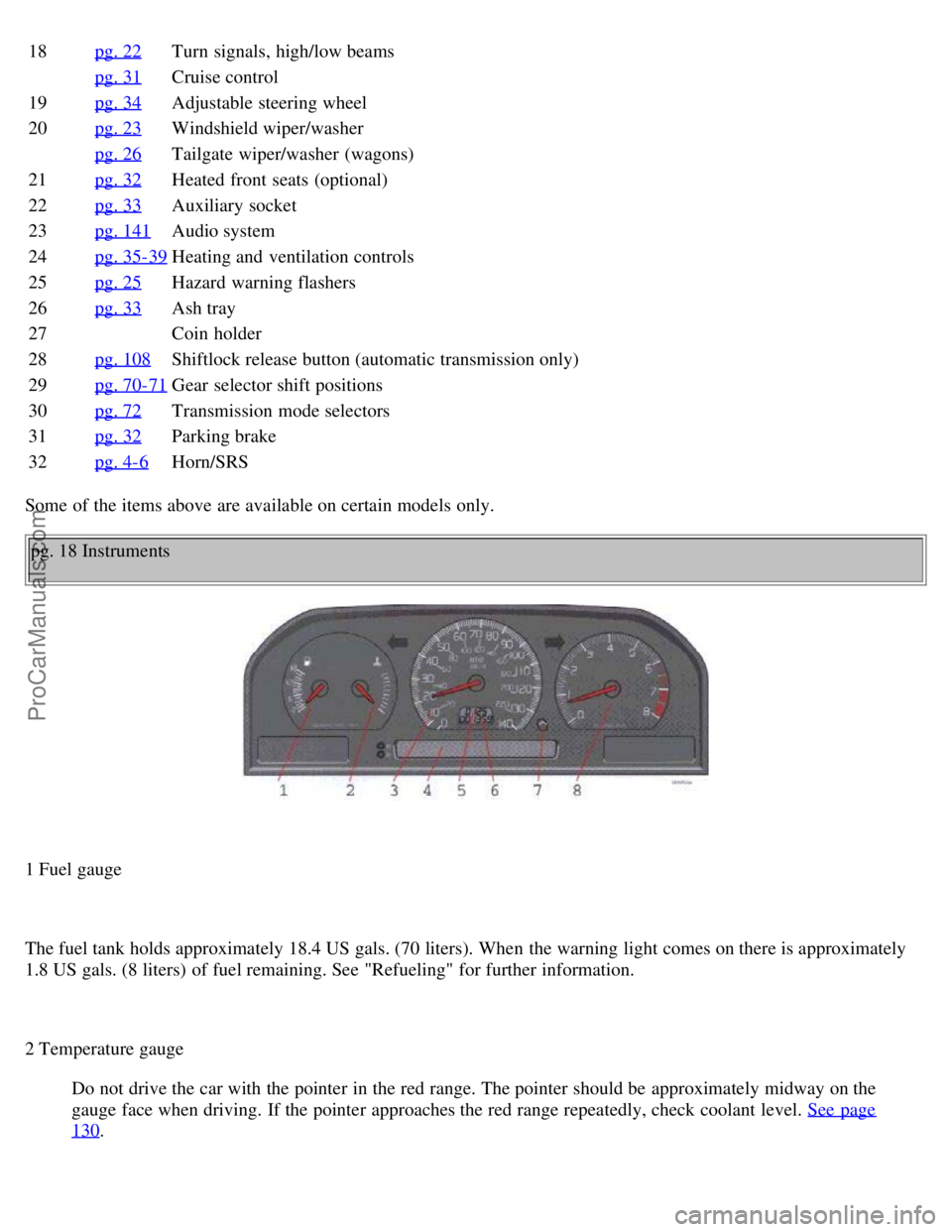
18pg. 22Turn signals, high/low beams
pg. 31Cruise control
19 pg. 34
Adjustable steering wheel
20 pg. 23
Windshield wiper/washer
pg. 26
Tailgate wiper/washer (wagons)
21 pg. 32
Heated front seats (optional)
22 pg. 33
Auxiliary socket
23 pg. 141
Audio system
24 pg. 35-39
Heating and ventilation controls
25 pg. 25
Hazard warning flashers
26 pg. 33
Ash tray
27 Coin holder
28 pg. 108
Shiftlock release button (automatic transmission only)
29 pg. 70-71
Gear selector shift positions
30 pg. 72
Transmission mode selectors
31 pg. 32
Parking brake
32 pg. 4-6
Horn/SRS
Some of the items above are available on certain models only.
pg. 18 Instruments
1 Fuel gauge
The fuel tank holds approximately 18.4 US gals. (70 liters). When the warning light comes on there is approximately
1.8 US gals. (8 liters) of fuel remaining. See "Refueling" for further information.
2 Temperature gauge Do not drive the car with the pointer in the red range. The pointer should be approximately midway on the
gauge face when driving. If the pointer approaches the red range repeatedly, check coolant level. See page
130.
ProCarManuals.com